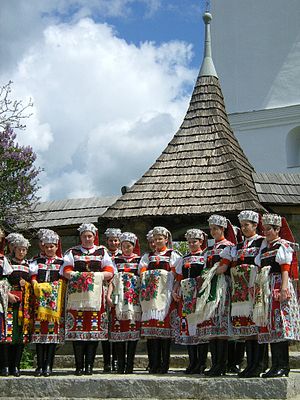| This article needs additional citations for verification. Please help improve this article by adding citations to reliable sources. Unsourced material may be challenged and removed. Find sources: "Țara Călatei" – news · newspapers · books · scholar · JSTOR (January 2021) (Learn how and when to remove this message) |
You can help expand this article with text translated from the corresponding article in Hungarian. (September 2011) Click for important translation instructions.
|

Țara Călatei (Hungarian: Kalotaszeg) is a region in Transylvania, Romania. It is one of the many areas in Western Romania with a significant Hungarian population, and is a stronghold of old Transylvanian Hungarian folk traditions.
Geography
Țara Călatei is a rural region situated just west of Cluj-Napoca, spanning across western Cluj County and southern Sălaj County. Its historical centre is the small town of Huedin. The region has an ethnically-mixed population, consisting mostly of Romanians, Hungarians, and Roma; its Jewish population suffered heavily during the Second World War. According to the 2011 Romanian census, ethnic Hungarians number about 20,000 people and form a minority of 30 percent of the total population.
Name
The region takes its name from the Călata people. The name formerly referred to a much larger territory; according to Lajos Kelemen's study on the history and monuments of Țara Călatei, the area reached from the Barcău River to the Crişul Repede River during the Middle Ages. The region as it is known today lies mainly west of Cluj-Napoca, although there are also some villages to the north and east as well which follow Kalotaszeg (Călata) customs.


The Hungarian community
Hungarians are the largest ethnic minority in the region, and make up a majority in some villages. The dominant religion amongst Hungarians in the region is Calvinism, with the exception of the village Leghia (Hungarian: Jegenye) which is Catholic; Huedin (Hungarian: Bánffyhunyad) also has a smaller Catholic church.
The churches of the region are typically painted white and encircled by a wall. Typically, they feature a tetragonal bell tower with a pointed wooden spire. Christian services are generally segregated by gender and age.
Female traditional clothing is distinguished through its highly colourful and ornate appearance, usually accented by pearl-laden headwear. Traditional clothing from the region is displayed in the ethnographic museums of both Budapest and Cluj-Napoca. Locals continue to preserve, produce and wear this type of clothing on special occasions.
The Hungarian Cultural Days of Cluj, an annual cultural festival held in August, features folk and cultural performances by artists from the region.
Țara Călatei in popular culture
The region was featured in the film Kalotaszegi Madonna ("Madonna from Țara Călatei", 1943), made in Northern Transylvania, when it was a part Kingdom of Hungary (1920–1946) between 1940–1944. The film takes place mainly in Cluj, but some scenes were shot elsewhere in the region.
Gallery
-
 Hungarian church of Văleni village
Hungarian church of Văleni village
-
 Romanian church of Agârbiciu, built during the 17th century
Romanian church of Agârbiciu, built during the 17th century
-
 Cover of the churche's organ in Mănăstireni
Cover of the churche's organ in Mănăstireni
-
 Romanian church of Fildu de Sus (in Sălaj County) built during the 18th century.
Romanian church of Fildu de Sus (in Sălaj County) built during the 18th century.
References
External links
46°48′00″N 23°08′00″E / 46.8000°N 23.1333°E / 46.8000; 23.1333
Category: